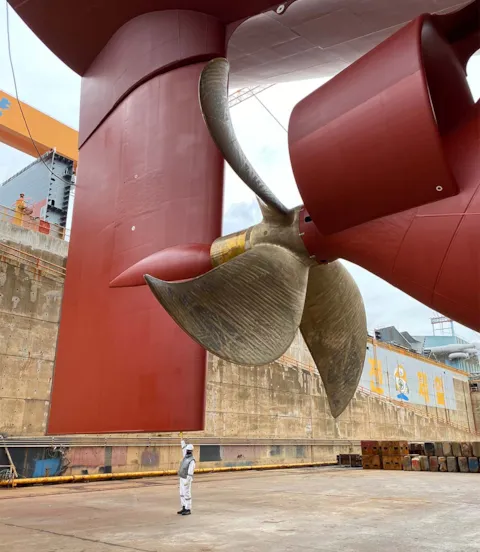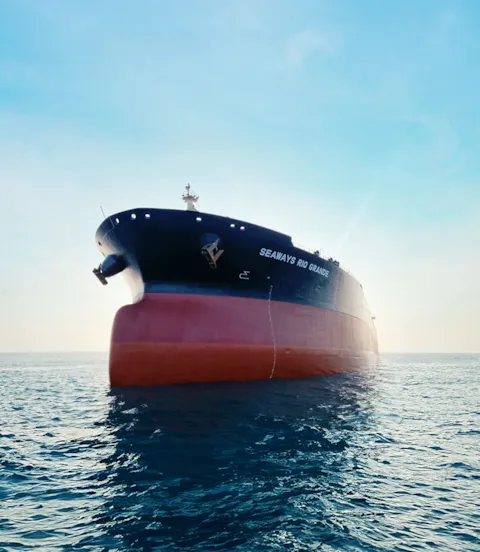Decarbonization in action: The successful journey of International Seaways with DNV
International Seaways, Inc. embarked on an ambitious journey to put its entire tanker fleet on course for decarbonization, supported by DNV. An overall strategy and decarbonization plans for all vessels will help the company to achieve regulatory compliance in a cost-effective way while reducing business risk.
Achieving greenhouse gas emission compliance for an entire fleet of vessels can be a very complex task, both methodically and financially, and knowing where to start is not the easiest part of it. This is why DNV’s Maritime Advisory team offers a structured approach that helps shipowners develop a fleet-wide decarbonization plan – and engage the organization to support it.
A fast follower: Putting sustainability centre stage
International Seaways, Inc. (INSW) is a well-known New York-based tanker owner with a fleet of roughly 80 vessels of various types and sizes. The company has worked with DNV for many years and turned to DNV for support with its decarbonization strategy and plans. “We are a listed public company, so we have to be very thoughtful about how we invest our money,” explains William Nugent, Senior Vice President and Chief Technical and Sustainability Officer at International Seaways. “Our shareholders expect us to be careful stewards of their investments.”
Seeing the broader trends in the industry and the global drive to decarbonize, INSW wants to be “a fast follower”, he adds. “This means that we need to look at how our existing and future fleet matches IMO’s and Europe’s decarbonization intentions and especially those of our stakeholders.” Sustainability criteria are typically embedded in today’s finance agreements, he points out, lauding the Poseidon Principles, which have helped create a level playing field for the shipping world.
DNV’s strategy report: Guiding INSW towards compliance
The purpose of the fleet-wide decarbonization strategy and plans DNV developed jointly with INSW was to enable the company to meet or exceed the IMO decarbonization trajectories and EU regulations in an economically feasible manner while minimizing business risk. DNV delivered a strategy report to provide INSW with a solid understanding of the regulatory environment and the available options to achieve compliance, including operational optimization recommendations for the years to come. Furthermore, the delivery included a fuel performance management report as well as a roadmap and capital expenditure schedule for every single vessel, delivered on DNV’s Veracity platform.
Periodical updates keep decarbonization plans relevant
Lois Zabrocky, President and Chief Executive Officer of International Seaways, summarizes the objectives: “Of course, we want a plan to reduce our emissions and extend the lifetime of the vessels as much as possible. Today, we have a plan to … look at the trajectory of our emissions and all the available opportunities for us to decarbonize.”
As a living document, the decarbonization plan is reviewed and updated periodically with help from DNV as the INSW organization builds knowledge, experience and confidence.
Alignment throughout the enterprise and beyond
“The first step we embarked on together with DNV was taking the temperature of the organization,” recalls Nugent. All parts of the INSW organization from the CEO down to the crews, along with external partners such as commercial vessel management and charterers, were asked to participate in surveys to provide their views of INSW, their current decarbonization efforts and related questions. “We also conducted a technical review across the fleet and updated our educational processes for the whole organization around what decarbonization means, the goals, issues and challenges,” says Nugent.

Turning evaluation insights into actionable decarbonization plans
“This stepwise effort, guided by DNV, was thoughtful, well-timed and in-depth; it highlighted areas where we were very strong and others where we had work to do. It was presented in a way that was clear, concise and solution-oriented.” The resulting insights enabled INSW to benchmark the company against decarbonization best practices and put in place the decision tools to change the internal dialogue around decarbonization, which took many workshops and meetings involving all levels of the organization. “DNV took an industry’s worth of insights, feedback and knowledge and turned it into something very specific and actionable for International Seaways,” says Nugent.

Indispensable prerequisite: A culture change
“The most important takeaway from this project was how critical the culture was to seeing these efforts through,” Nugent emphasizes. “To really effect a change and get commitment from the entire organization, you need to have a culture that supports and embraces it and is aligned and focused. The technical insights provided by DNV were substantial, and the cultural insights they brought to the table were even more valuable.”
DNV helped the company develop a line of argument that made it easier to gain the support of stakeholders, shareholders and the board of directors. “DNV gave us the facts and the tools to have these dialogues and do it genuinely,” says Nugent. “Soon there was a true understanding of what these facts and figures meant and how they would impact the business. We brought people along on this pathway, getting more and more granular and action-focused, more specific and directive. This was a learning and growing process.”

Maintaining a constructive dialogue on decarbonization with oil majors
Changing the internal dialogue helped change the dialogue externally as well. Sustainability and decarbonization are high on the agendas of INSW’s charterers, mainly oil majors. INSW’s decarbonization plans, from upgrading hull coatings to wind-assisted propulsion and LNG-fuelled VLCCs, are finding broad support. INSW also has six long-range tankers, called LR1s, on order which will be classed by DNV. “These will be stage-three dual-fuel ready, with the understanding that we will eventually convert them to operate on LNG or bio-LNG,” explains Nugent.
CEO Lois Zabrocky adds: “We have to move the company forward. When we were planning the LR1 project, we realized we shouldn’t order them purely based on economics or the price at the shipyard. We had to include an investment allowing us to convert these assets, which are built for a 25-year life in a ten-minute world.” The newbuild programme has generated interest from several other oil majors as well, says Nugent.

A decarbonization plan for every vessel
“We looked at every ship, its remaining life and the potential investments in light of the decarbonization regulations, evaluating the benefits of each technology and vessel in terms of costs and decarbonization. This has grounded us, helping us take away that abstract fear of the challenge,” says Nugent.
Advanced data harvesting technologies are helping INSW get ship operation information faster today, Zabrocky points out. “In the past, you’d have to wait six months to get some meaningful data that would allow you to see whether a ship was performing well. These timelines are shortening now, and that allows us to take initiatives quickly to keep that fleet operating properly.”

Action plans are delivering benefits
There is now a specific action plan for every INSW vessel, including installing new technology, monitoring and measuring, commercial management and interfaces, to see it through to the end of its life. “We not only look at each ship but also at the ship segments, accounting for trading patterns, fuel options, potential commercial changes. All of this is under constant review and revision,” says Nugent.
“There are multiple avenues of payback to this,” he adds. “Recognizing those is important: we are burning less fuel, which costs us less money and improves our outcome. Then there’s the decarbonization benefit that now, on a voyage in and out of Europe, has a monetary value that makes us more competitive if we have a more efficient ship.”

A continuous learning process
The decarbonization strategies and plans are now deeply embedded in the company’s strategic goals and management practices. “DNV helped INSW build that alignment and culture, define it and refine it,” Nugent stresses. “The organization is learning to carry the process forward on its own and become more self-reliant and independent. I can now hear our board members talk about it, our CEO, the teams on the ships, they all understand why we are asking them for this temperature, this pressure, and what benefits it can drive.”
Allan Krogsgaard, Business Development Director and Principal Surveyor at DNV, who has been deeply involved in the project, says the customer’s preparedness and positive approach to the decarbonization roadmap has been instrumental to its success: “All of our colleagues at DNV have been extremely happy and grateful for the transparency and sincere willingness of INSW to engage with us – we have also learned a lot from their operational experience.”
Nugent adds: “DNV proactively identifies the customers’ needs. It is that proactive sharing of information, and being an open, transparent source to the industry, that is so valuable.”

- International Seaways
